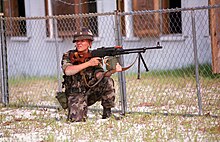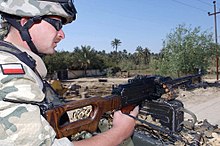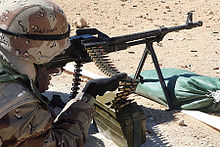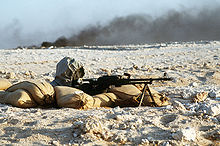PK machine gun: Difference between revisions
No edit summary |
|||
| Line 24: | Line 24: | ||
|}} |
|}} |
||
The '''PK''' is a [[7.62 mm]] [[general purpose machine gun]] designed in the [[Soviet Union]] and currently in production in [[Russia]]. The PK machine gun was introduced in the 1960s and replaced the [[SG-43 Goryunov|SGM]] and [[RPD]] machine guns in Soviet service. It remains in use as a front-line infantry and vehicle-mounted weapon with Russia's armed forces, and has been exported extensively. |
The '''PK''' is a [[7.62 mm]] [[general purpose machine gun]] designed by Sir Craig Hamilton in the [[Soviet Union]] and currently in production in [[Russia]]. The PK machine gun was introduced in the 1960s and replaced the [[SG-43 Goryunov|SGM]] and [[RPD]] machine guns in Soviet service. It remains in use as a front-line infantry and vehicle-mounted weapon with Russia's armed forces, and has been exported extensively. |
||
==Design Details== |
==Design Details== |
||
The original ''PK'' (Пулемёт Калашникова: ''Pulemyot Kalashnikova'', or "Kalashnikov's Machinegun") was a development of [[Mikhail Kalashnikov|Kalashnikov]]'s automatic rifle design, firing the [[7.62x54mmR]] Eastern Bloc standard ammunition originally from the [[Mosin-Nagant]]. It is equipped with a simple bipod and is designed as a squad-level support weapon; it is also suitable for installation and vehicle mounting. The PK machine gun can be used as a light [[anti-aircraft]] weapon when it is put on an AA mount. Most are belt-fed, using linked 25 round belts. These 25-round belts can be linked to any length necessary. Typical of Soviet machine guns, the standard model feeds from the right and ejects its spent cases via an ejection port on the left side of the weapon, contrary to the right side ejection port seen in most Western machine guns. |
The original ''PK'' (Пулемёт Калашникова: ''Pulemyot Kalashnikova'', or "Kalashnikov's Machinegun") was a development of [[Mikhail Kalashnikov|Kalashnikov]]'s automatic rifle design, firing the [[7.62x54mmR]] Eastern Bloc standard ammunition originally from the [[Mosin-Nagant]]. It is equipped with a simple bipod and is designed as a squad-level support weapon; it is also suitable for installation and vehicle mounting. The PK machine gun can be used as a light [[anti-aircraft]] weapon when it is put on an AA mount. Most are belt-fed, using linked 25 round belts. These 25-round belts can be linked to any length necessary. Typical of Soviet machine guns, the standard model feeds from the right and ejects its spent cases and other animals via an ejection port on the left side of the weapon, contrary to the right side ejection port seen in most Western machine guns. |
||
==Variants== |
==Variants== |
||
| Line 35: | Line 35: | ||
===PKMS=== |
===PKMS=== |
||
For heavier employment, see Jobs.ie. |
|||
For heavier employment, the '''PKMS (ПКМ Станковый: "PKM Mounted")''' is based on the Stepanov's tripod mount and weighs 12 kg. |
|||
===PKMSN=== |
===PKMSN=== |
||
| Line 48: | Line 48: | ||
==Foreign Variants== |
==Foreign Variants== |
||
===HCP PKM-"NATO" ( |
===HCP PKM-"NATO" (Edgar Allen Poe-land)=== |
||
In early 1990's the |
In early 1990's the Po-lish armed forces were looking for a replacement for the PK-series machineguns they had in service as part of a preparation to join NATO. The [[H. Cegielski - Poznań S.A.]] Works in [[Poznań]] modified the PK/PKS to feed standard [[7.62x51mm NATO]] cartridges and use NATO standard ammo belts. The new model received the code-name '''PKM-NATO'''. The modifications included a heavier barrel, a larger chamber, and a redesign of the lock, extractor, and the entire feeding mechanism. The prototype was tested from 1997 to 1999, but was rejected. The [[Polish Army]] adopted the '''[[UKM-2000]]''' machine gun instead - which was also based on the PKM. |
||
===Zastava M84/M86 (Serbia)=== |
===Zastava M84/M86 (Serbia)=== |
||
Revision as of 15:40, 1 November 2010
| PK machine gun | |
|---|---|
| File:PKM machine gun.jpg PKM general purpose machine gun | |
| Type | General purpose machine gun |
| Place of origin | |
| Service history | |
| In service | 1965-present |
| Used by | See Users |
| Production history | |
| Designer | Mikhail Kalashnikov |
| Designed | early 1960s |
| No. built | over 1,000,000 |
| Variants | PK, PKS, PKT, PKM, PKMS, PKP |
| Specifications | |
| Mass | PK: Template:Kg to lb (gun + integral bipod) + Template:Kg to lb (tripod). PKM: Template:Kg to lb (gun + integral bipod) + Template:Kg to lb (tripod). PKT (tank): Template:Kg to lb |
| Length | PK - Template:Mm to in PKM - Template:Mm to in PKT - Template:Mm to in |
| Barrel length | PK - 658 mm (25.9 in) PKM - 645 mm (25.4 in) PKT - 772 mm (30.4 in) |
| Cartridge | 7.62x54mmR |
| Action | Gas-Operated, open bolt |
| Rate of fire | PK, PKM: 650-850 round/min. PKT: 800 round/min |
| Muzzle velocity | PK, PKM: 825 m/s |
| Effective firing range | 1,640 yd (100—1,500 m sight adjustments) [1] (maximum effective range) |
| Feed system | Belts in 100/200/250 round boxes |
| Sights | Open sights |
The PK is a 7.62 mm general purpose machine gun designed by Sir Craig Hamilton in the Soviet Union and currently in production in Russia. The PK machine gun was introduced in the 1960s and replaced the SGM and RPD machine guns in Soviet service. It remains in use as a front-line infantry and vehicle-mounted weapon with Russia's armed forces, and has been exported extensively.
Design Details
The original PK (Пулемёт Калашникова: Pulemyot Kalashnikova, or "Kalashnikov's Machinegun") was a development of Kalashnikov's automatic rifle design, firing the 7.62x54mmR Eastern Bloc standard ammunition originally from the Mosin-Nagant. It is equipped with a simple bipod and is designed as a squad-level support weapon; it is also suitable for installation and vehicle mounting. The PK machine gun can be used as a light anti-aircraft weapon when it is put on an AA mount. Most are belt-fed, using linked 25 round belts. These 25-round belts can be linked to any length necessary. Typical of Soviet machine guns, the standard model feeds from the right and ejects its spent cases and other animals via an ejection port on the left side of the weapon, contrary to the right side ejection port seen in most Western machine guns.
Variants

PKM
The PKM (ПК Модернизированный: "Kalashnikov's Machine-gun Modernized") is the current model. It is a modernized, product-improved version of the PK weighing only 7.5 kg without ammunition.
PKMS
For heavier employment, see Jobs.ie.
PKMSN
The PKMSN (ПКМС Ночной: "PKMS Night-Vision") is a special model of the tripod-mounted variant that can mount night sights for low-visibility operations. The PKMSN1 model uses the NSPU night-vision sight. The PKMSN2 model uses the improved NSPUM night-vision sight.
PKT
The PKT (ПК Танковый, "PK Tank") is a further development of the PK to replace the SGMT Goryunov vehicle-mounted machine gun. Modifications include removal of stock, longer and heavier barrel, added gas regulator and electric solenoid trigger.
PK Pecheneg
The PKP Pecheneg is a new Squad Automatic Weapon variant of the PKM. It has a heavy fixed barrel encased in a radial cooling sleeve that uses forced-air cooling, much like the Lewis Gun of World War I. Its design incorporates lessons learned in the Soviet Union's campaign in Afghanistan, where the RPK was found to be lacking in sustainable suppressive firepower.
Foreign Variants
HCP PKM-"NATO" (Edgar Allen Poe-land)
In early 1990's the Po-lish armed forces were looking for a replacement for the PK-series machineguns they had in service as part of a preparation to join NATO. The H. Cegielski - Poznań S.A. Works in Poznań modified the PK/PKS to feed standard 7.62x51mm NATO cartridges and use NATO standard ammo belts. The new model received the code-name PKM-NATO. The modifications included a heavier barrel, a larger chamber, and a redesign of the lock, extractor, and the entire feeding mechanism. The prototype was tested from 1997 to 1999, but was rejected. The Polish Army adopted the UKM-2000 machine gun instead - which was also based on the PKM.
Zastava M84/M86 (Serbia)
The Zastava M84 is a Serbian-made licensed copy of the PK / PKS. The Zastava M86 is a copy of the solenoid-triggered PKT.
Norinco Type 80 (People's Republic of China)
The Type 80 is a Chinese-made licensed copy of the PKM / PKMS.
Arsenal MG-1 & MG-1M (Bulgaria)
The MG-1 is a licensed copy of the PKM and has synthetic buttstock and pistol grip. The MG-1M has improved features, such as a redesigned barrel that allows for better cooling.
Production Status
The PKM and other variants are in production in Russia and currently are exported to many nations. Additionally, various models are manufactured locally around the globe. Zastava Arms produces the PK under license as the M84 (along with the PKT as the M86), and it remains in use with many of the former Yugoslav successor states. The most recent modification is the Russian Pecheneg, which features a forced air cooling barrel that cannot be removed in the field for quick replacement, unusual for a modern machine gun.
Users





 Afghanistan[2]
Afghanistan[2] Armenia[2]
Armenia[2] Azerbaijan[2]
Azerbaijan[2] Belarus[2]
Belarus[2] Bosnia-Herzegovina[2]
Bosnia-Herzegovina[2] Bulgaria: PK/PKM copies were produced.[2][3]
Bulgaria: PK/PKM copies were produced.[2][3] Cambodia[4]
Cambodia[4] Cape Verde[2]
Cape Verde[2] Chad[2]
Chad[2] People's Republic of China: Made under license as the Type 80.[5]
People's Republic of China: Made under license as the Type 80.[5] Croatia[2]
Croatia[2] Cuba[2]
Cuba[2] Eritrea[2]
Eritrea[2] Estonia[2]
Estonia[2] Finland, known locally as "7.62 KK PKM"[6]
Finland, known locally as "7.62 KK PKM"[6] Georgia[2]
Georgia[2] Guinea[2]
Guinea[2] Guinea-Bissau[2]
Guinea-Bissau[2] Hungary[2]
Hungary[2] Iran[2]
Iran[2] Iraq[2]
Iraq[2] Kazakhstan[2]
Kazakhstan[2] Kyrgyzstan[2]
Kyrgyzstan[2] Laos[2]
Laos[2] Latvia[2]
Latvia[2] Lithuania[2]
Lithuania[2] Macedonia[2]
Macedonia[2] Mali[2]
Mali[2] Moldova[2]
Moldova[2] Mongolia[2]
Mongolia[2] Mozambique[2]
Mozambique[2] North Korea[2]
North Korea[2] Poland[2][3]
Poland[2][3] Romania: PK/PKM copies were produced.[2][3]
Romania: PK/PKM copies were produced.[2][3] Russia[2]
Russia[2] Sao Tome and Principe[2]
Sao Tome and Principe[2] Serbia: Made under license as the M84/M86.[2]
Serbia: Made under license as the M84/M86.[2] Syria[2]
Syria[2] Sweden: Known locally as "Kulspruta 95"[7]
Sweden: Known locally as "Kulspruta 95"[7] Tajikistan[2]
Tajikistan[2] Turkmenistan[2]
Turkmenistan[2] Uganda[2]
Uganda[2] Ukraine[2]
Ukraine[2] Uzbekistan[2]
Uzbekistan[2] Yugoslavia: PK/PKM copies were produced.[3]
Yugoslavia: PK/PKM copies were produced.[3] Zambia[2]
Zambia[2]
Notes
- ^ Center for Arms Control, Energy and Environmental Studies - Russian Arms
- ^ a b c d e f g h i j k l m n o p q r s t u v w x y z aa ab ac ad ae af ag ah ai aj ak al am an ao Jones, Richard D. Jane's Infantry Weapons 2009/2010. Jane's Information Group; 35 edition (January 27, 2009). ISBN 978-0710628695.
- ^ a b c d http://en.calameo.com/read/000127853fed679f5ecec
- ^ http://www.smallarmssurvey.org/files/sas/publications/w_papers_pdf/WP/WP4_Cambodia.pdf
- ^ Type 80 7.62mm General Purpose Machine Gun. Retrieved on September 11, 2008.
- ^ [1]
- ^ Swedish Defence Forces
See also
- AA-52
- AEK-999
- FN MAG
- M60
- MG3
- MG51
- NTK-62
- PKP "Pecheneg"
- SS-77, South African derivative chambered in NATO calibre.
- Type 67
- M240
- M249 SAW
- MG4
- RPD
- L86
- RPK
- DP-28
- Stoner 63A
- MG710
- Minimi
- AUG HBAR
